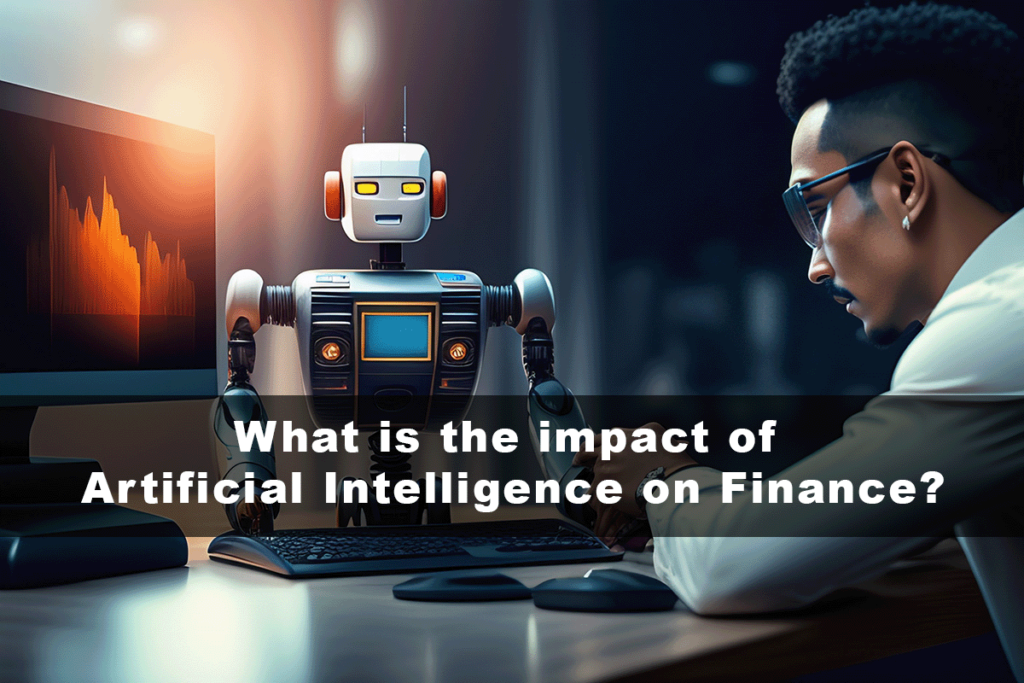Table of Contents
In the rapidly evolving landscape of modern business, the fusion of finance and artificial intelligence (AI) has emerged as a groundbreaking phenomenon that is reshaping industries and strategies across the globe. This article delves into the intricate relationship between finance and AI, highlighting the lessons we can glean from their intertwined journey.

Unveiling the Power of Predictive Analytics
In the realm of finance, the integration of artificial intelligence has ushered in an era of predictive analytics that empowers organizations to anticipate market trends, customer behavior, and financial fluctuations with unparalleled accuracy. By harnessing AI algorithms and machine learning models, businesses can now make informed decisions driven by data-driven insights, minimizing risks and maximizing profitability.
The financial sector has reaped substantial benefits from predictive analytics. By analyzing historical data and identifying patterns, AI algorithms can forecast market movements and potential investment opportunities. This technology-driven approach has not only streamlined investment strategies but has also offered a competitive edge to financial institutions.
Revolutionizing Customer Experience
AI has revolutionized the way financial institutions interact with customers. Chatbots and virtual assistants have become instrumental in delivering real-time customer support, resolving queries, and providing personalized recommendations. This transformation in customer service has led to enhanced user experiences, increased customer satisfaction, and improved brand loyalty.
The incorporation of AI-driven chatbots has enabled financial institutions to provide round-the-clock assistance, effectively bridging the gap between customers’ needs and service availability. Furthermore, AI’s ability to analyze customer preferences and behaviors has enabled the creation of tailor-made financial solutions that align with individual requirements.
Mitigating Risks through Algorithmic Trading
Algorithmic trading, powered by artificial intelligence, has emerged as a cornerstone of modern finance. This automated approach to trading leverages complex algorithms to execute transactions at high speeds, taking into account market trends and real-time data. This technique not only minimizes human error but also enhances the efficiency of trading operations.
By swiftly responding to market fluctuations and executing trades with precision, algorithmic trading has the potential to generate higher returns while mitigating the risks associated with emotional decision-making. Financial institutions employing this strategy can capitalize on fleeting market opportunities and optimize portfolio management.

Enhancing Fraud Detection and Security
The marriage of finance and AI has also proven pivotal in the realm of security and fraud detection. Traditional methods of fraud prevention often fall short in the face of sophisticated cyber threats. However, AI’s advanced capabilities in anomaly detection and pattern recognition have bolstered the defense mechanisms of financial institutions.
AI algorithms can swiftly analyze vast amounts of data to detect irregularities, flagging potentially fraudulent activities in real time. This proactive approach not only safeguards the interests of customers but also preserves the reputation and integrity of financial organizations.
FAQ’s
Q: How does the integration of Finance and Artificial Intelligence reshape industries?
A: The integration of Finance and Artificial Intelligence reshapes industries by revolutionizing predictive analytics, customer experiences, algorithmic trading, and security measures.
Q: What are the benefits of incorporating Finance and Artificial Intelligence together?
A: Incorporating Finance and Artificial Intelligence together offers benefits such as enhanced accuracy in predictions, streamlined operations, improved customer interactions, and effective risk management.
Q: Can Finance and Artificial Intelligence collectively predict market trends accurately?
A: Yes, Finance and Artificial Intelligence can accurately predict market trends through advanced predictive analytics, analyzing historical data and patterns.
Q: How does predictive analytics enhance decision-making in Finance and Artificial Intelligence?
A: Predictive analytics in Finance and Artificial Intelligence enhance decision-making by utilizing AI algorithms to anticipate market movements and optimize investment strategies.
Q: What role do AI algorithms play in shaping investment strategies in Finance and Artificial Intelligence?
A: AI algorithms play a pivotal role in shaping investment strategies in Finance and Artificial Intelligence by analyzing data to identify trends, potential investment opportunities, and risks.
Q: How has the synergy between Finance and Artificial Intelligence improved customer experiences in the financial sector?
A: The synergy between Finance and Artificial Intelligence has enhanced customer experiences through AI-powered chatbots, offering real-time support, personalized recommendations, and 24/7 assistance.
Q: What are AI-driven chatbots, and how do they contribute to customer experiences in Finance and Artificial Intelligence?
A: AI-driven chatbots are automated virtual assistants that significantly contribute to customer experiences in Finance and Artificial Intelligence by providing immediate support, quick query resolution, and personalized financial advice.
Q: In what ways does algorithmic trading leverage the potential of Finance and Artificial Intelligence?
A: Algorithmic trading harnesses the potential of Finance and Artificial Intelligence by automating trade executions based on real-time data and pre-defined strategies, minimizing human error.
Q: What advantages does algorithmic trading offer over traditional methods in the realm of Finance and Artificial Intelligence?
A: Algorithmic trading in Finance and Artificial Intelligence offers advantages such as rapid execution, leveraging real-time data and market trends, leading to improved risk management and efficiency.
Q: How does the integration of Finance and Artificial Intelligence mitigate risks in financial transactions?
A: The integration of Finance and Artificial Intelligence mitigates risks by analyzing data to detect anomalies and irregularities, enabling early identification and prevention of fraudulent activities.
Q: How do Finance and Artificial Intelligence contribute to fraud detection and prevention?
A: Finance and Artificial Intelligence contribute to fraud detection and prevention by utilizing advanced algorithms for pattern recognition and anomaly detection, effectively safeguarding institutions and customers.
Q: Can you provide real-world examples of AI applications within the domains of Finance and Artificial Intelligence?
A: Real-world AI applications within the domain of Finance and Artificial Intelligence include robo-advisors for investment management, credit scoring, fraud detection algorithms, and algorithmic trading systems.
Q: How does AI contribute to enhancing the security of financial institutions within the framework of Finance and Artificial Intelligence?
A: AI contributes to enhancing the security of financial institutions within the framework of Finance and Artificial Intelligence by detecting and responding to cyber threats, safeguarding sensitive financial data, and preserving institutions’ reputations.
Q: Could you explain the concept of anomaly detection and its significance in Finance and Artificial Intelligence?
A: Anomaly detection, a significant concept in Finance and Artificial Intelligence, involves using AI to identify unusual patterns or deviations from the norm in financial transactions, playing a crucial role in fraud prevention.
Q: What lessons can other industries draw from the successful integration of Finance and Artificial Intelligence?
A: Other industries can draw valuable lessons from the successful integration of Finance and Artificial Intelligence, learning about data-driven decision-making, improved customer experiences, and operational optimization.
Q: What challenges and obstacles arise when implementing AI in the context of Finance and Artificial Intelligence?
A: Challenges and obstacles that arise when implementing AI in the context of Finance and Artificial Intelligence include data privacy concerns, algorithm bias, and the necessity for skilled AI professionals to ensure successful integration.
Q: How does AI contribute to portfolio optimization and management within the purview of Finance and Artificial Intelligence?
A: AI contributes to portfolio optimization and management within the purview of Finance and Artificial Intelligence by analyzing market data to suggest optimal investment portfolios, balancing risk and return.
Q: What role does machine learning play in enhancing financial services within the realm of Finance and Artificial Intelligence?
A: Machine learning plays a pivotal role in enhancing financial services within the realm of Finance and Artificial Intelligence by enabling AI systems to learn from data, leading to improved credit risk assessment, personalized financial advice, and fraud detection.
Q: How can businesses ensure responsible and ethical use of AI within Finance and Artificial Intelligence?
A: Businesses can ensure responsible and ethical use of AI within Finance and Artificial Intelligence by transparently communicating AI’s role, addressing bias, adhering to regulations, and conducting regular audits of AI systems.

Conclusion
The convergence of finance and artificial intelligence has transcended traditional paradigms, ushering in a new era of efficiency, accuracy, and innovation. As organizations continue to harness the power of predictive analytics, revolutionize customer experiences, optimize trading strategies, and enhance security measures, the symbiotic relationship between finance and AI will undoubtedly shape the trajectory of industries for years to come. The lessons learned from this intersection are instrumental for businesses seeking to thrive in an ever-evolving digital landscape.

7 thoughts on “Exploring the Synergy Between Finance and Artificial Intelligence”